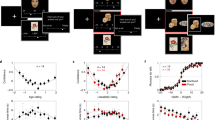Abstract
Many factors can influence, or bias, human decision making. A considerable amount of research has investigated the neural correlates of such biases, mostly correlating hemodynamic responses in brain areas with some aspect of the decision. These studies, typically done using functional magnetic resonance imaging or positron emission tomography, have provided useful information about the location of processing in the brain. However, comparatively little research has examined when these processes occur. The present experiment addressed this question by using magnetoencephalography (MEG) to record brain activity while subjects chose preferred options from decision sets. We found that MEG signal deviations for biased decisions occurred as early as 250–750 ms following stimulus onset. Such deviations occurred earliest in sensors over the right anterior cortex. These findings improve our understanding of temporal dynamics of decision biases and suggest ways that existing explanations for this bias could be refined.






Similar content being viewed by others
References
Armitage P (1975) Sequential medial trials, 2nd edn. Blackwell, Oxford
De Martino B, Kumaran D, Seymour B, Dolan RJ (2006) Frames, biases, and rational decision-making in the human brain. Science 313:684–687
Delaney L, Rawdon C, Denny K, Zhang W, Roche R (2008) Event-related potentials reveal differential brain regions implicated in discounting in two tasks. UCD Geary Institute Discussion Paper Series
Dhar R, Simonson I (2003) The effect of forced choice on choice. J Mark Res 6:146–160
Dickhaut J, McCabe K, Nagode JC, Rustichini A, Smith K, Pardo JV (2003) The role of context in choice: the effect of different comparison gambles on revealed preferences. Proc Natl Acad Sci USA 100:3536–3541
Gehring WJ, Willoughby AR (2002) The medial frontal cortex and the rapid processing of monetary gains and losses. Science 295:2279–2282
Hedgcock W, Rao A (2009) Trade-off aversion as an explanation for the attraction effect: a functional magnetic resonance imaging study. J Mark Res 46:1–13
Hewig J, Trippe R, Hecht H, Coles MGH, Holroyd CB, Miltner WHR (2006) Decision-making in blackjack: an electrophysical analysis. Cereb Cortex 17:865–877
Huber J, Puto C (1983) Market boundaries and product choice: illustrating attraction and substitution effects. J Consum Res 10:31–44
Huber J, Payne JW, Puto C (1982) Adding asymmetrically dominated alternatives: violations of regularity and the similarity hypothesis. J Consum Res 9:90–98
Huettel SA, Misiurek J (2004) Modulation of prefrontal cortex activity by information toward a decision rule. Neuroreport 15:1883–1886
Leuthold AC (2003) Subtraction of heart artifact from MEG data: the matched filter revisited. Society for neuroscience 33rd annual meeting, New Orleans LA
Luce MF (1998) Choosing to avoid: co** with negatively emotion-laden consumer decisions. J Consum Res 24:409–433
McClure SM, Laibson DI, Loewenstein G, Cohen JD (2004a) Separate neural systems value immediate and delayed monetary rewards. Science 306:503–507
McClure SM, Li J, Tomlin D, Cypert KS, Montague LM, Montague PR (2004b) Neural correlates of behavioral preference for culturally familiar drinks. Neuron 44:379–387
Pettibone JC, Wedell DH (2000) Examining models of nondominated decoy effects across judgment and choice. Organ Behav Hum Decis Process 81(2):300–328
Poldrack RA (2006) Can cognitive processes be inferred from neuroimaging data? Trends Cogn Sci 10:59–63
Polezzi D, Lotto L, Daum I, Sartori G, Rumiati R (2008) Predicting outcomes of decisions in the brain. Behav Brain Res 187:116–122
Schutter DJLG, de Haan EHF, van Honk J (2004) Anterior asymmetrical alpha activity predicts Iowa gambling performance: distinctly but reversed. Neuropsychologica 42:939–943
Shiv B, Loewenstein G, Bechara A, Damasio H, Damasio AR (2005) Investment behavior and the negative side of emotion. Psychol Sci 16:435–439
Simonson I (1989) Choice based on reasons: the case of attraction and compromise effects. J Consum Res 16:158–174
Soon CS, Brass M, Heinze H, Haynes J (2008) Unconscious determinants of decisions in the human brain. Nat Neurosci 11:543–545
Storbach P, Abraham-Fuchs K, Härer W (1994) Event-synchronous cancellation of the heart interference in biomedical signals. IEEE Trans Biomed Eng 41:343–350
Wedell DH, Pettibone JC (1996) Using judgments to understand decoy effects in choice. Organ Behav Hum Decis Process 67:326–344
Yun K, Chung D, Jeong J (2008) Emotional interactions in human decision-making using EEG hyperscanning. International conference of cognitive science, Seoul, Korea
Acknowledgments
We are indebted to Joseph Redden, Paul Johnson, Allan Chen, and Akshay Rao for their comments on an earlier draft of this manuscript. This research was supported by the University of Minnesota Center for Cognitive Sciences, the Department of Veterans Affairs, and the American Legion Brain Sciences Chair.
Author information
Authors and Affiliations
Corresponding author
Rights and permissions
About this article
Cite this article
Hedgcock, W.M., Crowe, D.A., Leuthold, A.C. et al. A magnetoencephalography study of choice bias. Exp Brain Res 202, 121–127 (2010). https://doi.org/10.1007/s00221-009-2117-6
Received:
Accepted:
Published:
Issue Date:
DOI: https://doi.org/10.1007/s00221-009-2117-6




